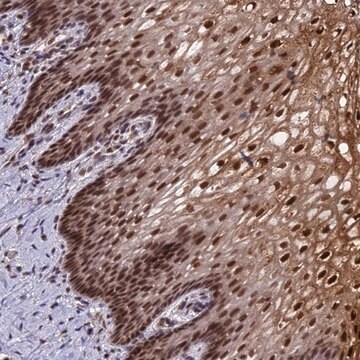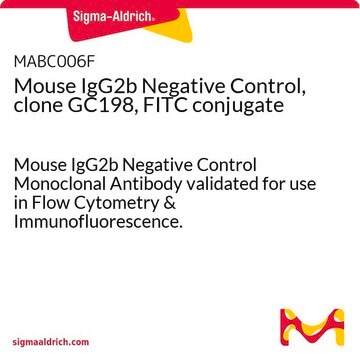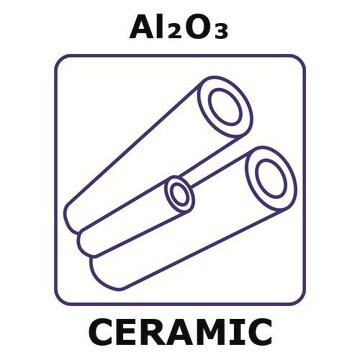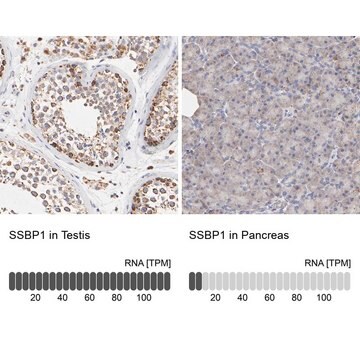MABE1057
Anti-ADA3 Antibody, clone 5C9/C8
clone 5C9/C8, from mouse
Synonym(e):
Transcriptional adapter 3, ADA3 homolog, ADA3-like protein, Alteration/deficiency in activation 3, hADA3, STAF54, Transcriptional adapter 3-like
About This Item
Empfohlene Produkte
Biologische Quelle
mouse
Qualitätsniveau
Antikörperform
purified immunoglobulin
Antikörper-Produkttyp
primary antibodies
Klon
5C9/C8, monoclonal
Speziesreaktivität
human, mouse
Methode(n)
ChIP: suitable
immunocytochemistry: suitable
immunohistochemistry: suitable (paraffin)
western blot: suitable
Isotyp
IgG1κ
NCBI-Hinterlegungsnummer
UniProt-Hinterlegungsnummer
Versandbedingung
ambient
Posttranslationale Modifikation Target
unmodified
Angaben zum Gen
human ... TADA3(10474)
Allgemeine Beschreibung
Spezifität
Immunogen
Anwendung
Epigenetik & nukleäre Funktionen
Chromatin Immunoprecipitation (ChIP) Analysis: A representative lot detected ADA3 occupancy at the X chromosome centromere HOR region, the kinetochore assembly site also occupied by CENP-A and CENP-B, using TERT-immortalized human mammary epithelial cell 76N-TERT chromatin preparation. shRNA-mediated ADA3 knockdown led to a reduction in CENP-B, but not CENP-A, recruitment to the HOR region (Mohibi, S., et al. (2015). J. Biol. Chem. 290(47):28299-28310).
Immunocytochemistry Analysis: A representative lot detected ADA3 nuclear immunoreactivity in untransfected, but not ADA3 shRNA-transfected, TERT-immortalized human mammary epithelial 76N-TERT cells by fluorescent immunocytochemistry staining of 4% formaldehyde-fixed cells. Dual fluorescent staining revealed ADA3 and CENP-B nuclear colocalization (Mohibi, S., et al. (2015). J. Biol. Chem. 290(47):28299-28310).
Western Blotting Analysis: Representative lots detected both the endogenous mouse ADA3 (mADA3) and the exogenously expressed human ADA3 (hADA3) in Ada3FL/FL MEFs virally infected to express FLAG-tagged full-length or a.a. 111-432 hADA3 constructs. Cre recombinase expression downregulated only mADA3, but not hADA3 (Mohibi, S., et al. (2015). J. Biol. Chem. 290(47):28299-28310; Mohibi, S., et al. (2012). J. Biol. Chem. 287(35):29442-29456).
Western Blotting Analysis: A representative lot detected ADA3 expression levels among a panel of mouse tissues (Mohibi, S., et al. (2012). J. Biol. Chem. 287(35):29442-29456).
Qualität
Western Blotting Analysis: A 1:1,000 dilution of this antibody detected ADA3 in 10 µg of MCF-7 cell lysate.
Zielbeschreibung
Physikalische Form
Lagerung und Haltbarkeit
Sonstige Hinweise
Haftungsausschluss
Sie haben nicht das passende Produkt gefunden?
Probieren Sie unser Produkt-Auswahlhilfe. aus.
Lagerklassenschlüssel
12 - Non Combustible Liquids
WGK
WGK 1
Flammpunkt (°F)
Not applicable
Flammpunkt (°C)
Not applicable
Analysenzertifikate (COA)
Suchen Sie nach Analysenzertifikate (COA), indem Sie die Lot-/Chargennummer des Produkts eingeben. Lot- und Chargennummern sind auf dem Produktetikett hinter den Wörtern ‘Lot’ oder ‘Batch’ (Lot oder Charge) zu finden.
Besitzen Sie dieses Produkt bereits?
In der Dokumentenbibliothek finden Sie die Dokumentation zu den Produkten, die Sie kürzlich erworben haben.
Unser Team von Wissenschaftlern verfügt über Erfahrung in allen Forschungsbereichen einschließlich Life Science, Materialwissenschaften, chemischer Synthese, Chromatographie, Analytik und vielen mehr..
Setzen Sie sich mit dem technischen Dienst in Verbindung.







